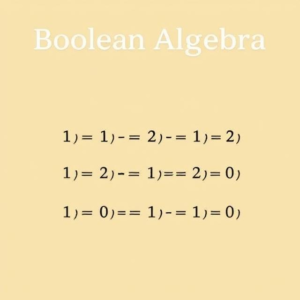What is Boolean Algebra?
Boolean Algebra is a type of mathematics that deals with true/false values, often represented as 1 and 0, and the rules for combining them. It’s used a lot in digital electronics (like computers and logic circuits) to describe how data is processed and manipulated.
In Boolean algebra, we work with variables that can either be true (1) or false (0). Just like regular algebra, we use operations to combine these values, but the operations are based on logic, not regular numbers.

Basic Concepts of Boolean Algebra
There are three main operations in Boolean algebra: AND, OR, and NOT. These operations follow certain rules that are different from regular arithmetic.
1. AND Operation (·):
- The AND operation requires both values to be true (1) for the result to be true (1). If either or both values are false (0), the result will be false (0).
- Symbol:
A · BorA AND B - Truth Table:
A B A AND B 0 0 0 0 1 0 1 0 0 1 1 1 - Example: If you have two conditions, say “Is it raining?” (A) and “Do I have an umbrella?” (B), the AND operation means you’ll be safe from getting wet only if both are true (raining AND umbrella).
2. OR Operation (+):
- The OR operation only requires one of the values to be true (1) for the result to be true (1). The result is only false (0) if both values are false (0).
- Symbol:
A + BorA OR B - Truth Table:
A B A OR B 0 0 0 0 1 1 1 0 1 1 1 1 - Example: Imagine two conditions, “Do I have an umbrella?” (A) and “Is it raining?” (B). The OR operation means you’ll be fine if either one is true (having an umbrella OR it’s raining). If neither is true, then you’ll get wet!
3. NOT Operation (‘):
- The NOT operation simply inverts the value. If a value is true (1), it becomes false (0), and if it’s false (0), it becomes true (1).
- Symbol:
A'orNOT A - Truth Table:
A NOT A 0 1 1 0 - Example: If A represents “Is it raining?” (where 1 = yes, 0 = no), then NOT A would mean “It is not raining.” If it’s true (1), then NOT A would be false (0), and vice versa.
Key Boolean Algebra Laws (Rules)
Boolean algebra has some key laws that help simplify expressions. Here are a few important ones:
1. Identity Law:
- AND Identity:
A · 1 = A(Anything AND 1 is the same as the original value) - OR Identity:
A + 0 = A(Anything OR 0 is the same as the original value)
2. Null Law:
- AND with 0:
A · 0 = 0(Anything AND 0 is always 0) - OR with 1:
A + 1 = 1(Anything OR 1 is always 1)
3. Complement Law:
- AND with complement:
A · A' = 0(A AND NOT A is always 0, because one is true and the other is false) - OR with complement:
A + A' = 1(A OR NOT A is always 1, because one is true and the other is false)
4. Double Negation Law:
- NOT NOT:
(A')' = A(Taking the NOT of something twice brings it back to the original value)
5. Commutative Law:
- AND:
A · B = B · A(The order doesn’t matter for AND) - OR:
A + B = B + A(The order doesn’t matter for OR)
6. Distributive Law:
- AND over OR:
A · (B + C) = (A · B) + (A · C) - OR over AND:
A + (B · C) = (A + B) · (A + C)
Real-Life Example of Boolean Algebra:
Let’s say you’re creating a simple system for turning on a light based on two conditions:
- A: Is it nighttime? (True if it’s nighttime)
- B: Is the light switch ON? (True if the switch is ON)
You could describe the logic for turning the light on using Boolean algebra:
- If it’s nighttime AND the light switch is ON, then the light will be ON. This can be written as:
Light = A · B
Or, if you want the light to turn ON if it’s nighttime OR the light switch is ON, it would look like this:
Light = A + B
In this case, you use Boolean logic to model and control a real-world situation!
Why is Boolean Algebra Important?
- Digital Electronics: Boolean algebra is used to design circuits (like logic gates in computers and smartphones).
- Computers: Every decision in a computer is based on Boolean logic, from basic calculations to complex programs.
- Programming: Many programming languages use Boolean logic for making decisions (e.g.,
ifstatements).
Summary:
- Boolean Algebra is the math behind logic gates and decision-making in electronics.
- It uses simple operations like AND, OR, and NOT to work with true/false (1/0) values.
- It’s foundational for designing digital circuits, computers, and solving problems in computer science and electronics.
Tags: 1, A AND B, A NOT, A OR B, AND operation, binary, binary variables, Boolean Algebra, Boolean expressions, circuit simplification, commutative law, complement, complement law, computer logic, computer science, conditional logic, digital computation, digital electronics, digital systems, distributive law, double negation law, Electronics, identity law, light control logic, Logic, logic circuits, logic design, Logic Gates, Logic operations, logical decision-making, logical statements., NOT operation, null law, OR operation, programming logic, real-life Boolean examples, switch logic, true/false values, truth table


